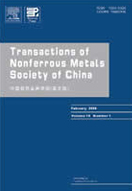Engineering heterogeneous microstructures for enhanced strength and ductility in air-cooled Al-Mg-Si alloys
(1. School of Aerospace Engineering, North University of China, Taiyuan 030051, China;
2. Key Laboratory of Material Chemistry for Energy Conversion and Storage, Ministry of Education, Hubei Key Laboratory of Material Chemistry and Service Failure, School of Chemistry and Chemical Engineering, Huazhong University of Science and Technology, Wuhan 430074, China;
3. R&D Material Division, Press Metal International Ltd., Foshan 528137, China;
4. School of Mechanical Engineering, North University of China, Taiyuan 030051, China)
2. Key Laboratory of Material Chemistry for Energy Conversion and Storage, Ministry of Education, Hubei Key Laboratory of Material Chemistry and Service Failure, School of Chemistry and Chemical Engineering, Huazhong University of Science and Technology, Wuhan 430074, China;
3. R&D Material Division, Press Metal International Ltd., Foshan 528137, China;
4. School of Mechanical Engineering, North University of China, Taiyuan 030051, China)
Abstract: The heterogeneity of α-Al(Fe,Mn)Si dispersoids and β″ precipitates was tuned to enhance the strength- ductility synergy of air-cooled Al-Mg-Si alloys. Scanning electron microscopy (SEM) and transmission electron microscopy (TEM) were employed to elucidate the microstructural parameters of these two strengthening phases. The results show that the microstructural heterogeneity can be triggered by the absence of homogenization, resulting in the presence of dispersoid-free zones (DFZs) and dispersoid zones (DZs), in conjunction with bimodal β″ precipitates. Further analytical calculations, from the strengthening model, clarify that the strategically dispersed α-Al(Fe,Mn)Si and β″ particles create “soft” and “hard” domains within the alloy, resultantly improving the mechanical properties.
Key words: Al-Mg-Si alloy; microstructure heterogeneity; dispersoid; nanoprecipitate; mechanical property

